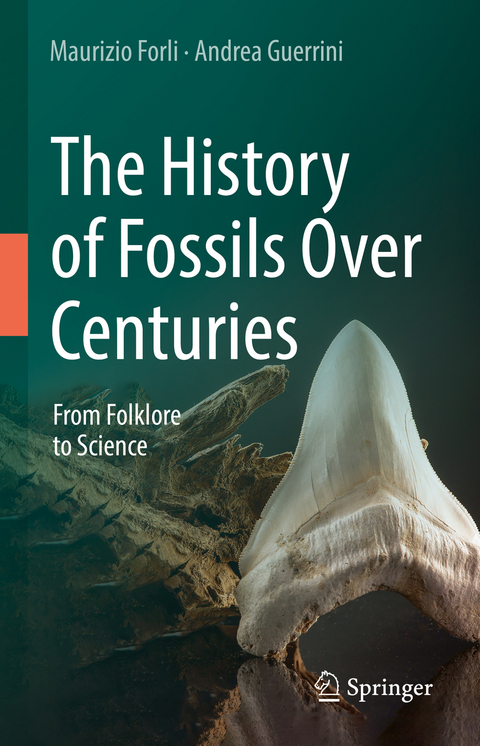
The History of Fossils Over Centuries
Springer International Publishing (Verlag)
978-3-031-04686-5 (ISBN)
As a point of reference for each fossil group treated, the authors have considered indispensable the use of ancient prints as evidence of the first iconographic sources dedicated to fossils, starting from those in the late fifteenth century, dedicated to the most common groups of invertebrates without neglecting a necessary exception, the ichthyodontolites, fundamental in the discussion in Italy on the interpretation of the organic origin of fossils, and from the end of the sixteenth century to about half of the eighteenth century. The abundant iconographic apparatus used, often unpublished or specially reworked, is essential and functional to the understanding of the various aspects addressed, a visual complement to the text and vice versa, designed and used taking its cue from the need imposed on early scholars to document their discoveries visually. Among the chosen images there is no shortage of original attributions to fossil finds that have been poorly understood or misidentified until now.
The English translation ofthis book from its Italian original manuscript was done with the help of artificial intelligence (machine translation by the service provider DeepL.com). A subsequent human revision of the content was done by the authors.
lt;b>Maurizio Forli (Rosignano M.mo, Leghorn, 1954). Interested since childhood in natural sciences, with preferences for paleontology and malacology. Various graphic and artistic experiences. Curator of the organization and preparation of numerous expositions, conventions and initiatives of scientific disseminations, he has published at the moment, over forty scientific articles of fossil malacology and numerous others on handouts catalogs and magazines. Co-author of books on the Italian Plio-Pleistocene malacofauna, particularly from Tuscany, has recently published with Andrea Guerrini "Storia Naturale della Toscana" and with another co-author "The family Rissoidae Gray, 1847 from Miocene to Present-day in the Mediterranean basin" (Danaus Editions). Active member of the Gruppo Archeologico e Paleontologico Livornese, he is member of the Italian Paleontological Society and of the Società Italiana di Malacologia.
Andrea Guerrini (Leghorn 18/2/1968). TSRM and graduated in Natural Sciences in 2007 (University of Pisa), scholar of Paleontology, he attended the online courses BipedalismX Course: The Science of UprightWalking - Dartmouth University (Prof. Jeremy DeSilva), ASM246x Human Origins Course - Arizona State University (Prof. Don Johanson) and Forensic Archaeology and Anthropology - Durham and Teesside University. He is a member of the Italian Paleontological Society, Società Toscana di Scienze Naturali and an active member of the Gruppo Archeologico e Paleontologico Livornese. He is the author of papers on palaeontology and on paleoradiology. He is co-author of the book of palaeontology "Storia Naturale del Pianeta Terra", Vol. I and II (Pacini Publisher) and "Storia Naturale della Toscana" (Danaus Editions).
Chapter1. Introduction.- Chapter2. Fossilia and fossils: considerations on their understanding over the centuries.- Chapter3. Fossils, stones and magic.- Chapter4. The classification of living beings: Carl Nilsson Linnæus and systematics.- Chapter5. The "Giuseppe Bellucci" Amulet Collection.- Chapter6. Quaestio de fossilibus - Glossopetre, Snake tongues, Ceraunie.- Chapter7. Ichthyodontoliths, bony fish teeth - Bufonites, Snake eyes.- Chapter8. Corals - Stellaria or Stregonia stone.- Chapter9. Nummulites - Devil's Coins.- Chapter10. Mollusca.- Chapter11. Polyplacophora or Chitons- Oscabryons.- Chapter12. Bivalvia - Devil's nails.- Chapter13. Curiosity: The Strange Mussels of Mr Van Aken.- Chapter14. Gastropoda - Opercula, Eyes of St. Lucia.- Chapter15. Scaphopoda - Shrieking Bones - Sympathetic Straws.- Chapter16. Cephalopoda: Belemnoidea - Lyncurium - Lynx stone - Points of Lightning.- Chapter17. Cephalopoda: Ammonoidea - Ammon's horns, Stone snakes.- Chapter18. Brachiopoda - Histerolithi.- Chapter19. Echinodermata.- Chapter20. Echinoidea - Snake eggs, Judaic Stones, Ombrie.- Chapter21. Crinoidea - Fairy coins.- Chapter22. Asteroidea and Ophiuroidea.- Chapter23. Arthropoda: Trilobite - Enthomolithi.- Chapter24. Coffee break - Chelicerata Heymons, 1901.- Chapter25. Arthropoda: Crustacea.- Chapter26. Crustacea: Cirripeda - Balani, Lepas & Ducks.
| Erscheinungsdatum | 24.08.2022 |
|---|---|
| Zusatzinfo | XV, 508 p. 374 illus., 295 illus. in color. |
| Verlagsort | Cham |
| Sprache | englisch |
| Maße | 155 x 235 mm |
| Gewicht | 900 g |
| Themenwelt | Geisteswissenschaften ► Archäologie |
| Naturwissenschaften ► Biologie ► Zoologie | |
| Naturwissenschaften ► Geowissenschaften ► Geologie | |
| Naturwissenschaften ► Geowissenschaften ► Mineralogie / Paläontologie | |
| Schlagworte | Arthropoda • Brachiopoda • Corals • Echinodermata • Fossil classification • fossil history • Gastropoda • molluscs • Nummulites • paleontology |
| ISBN-10 | 3-031-04686-2 / 3031046862 |
| ISBN-13 | 978-3-031-04686-5 / 9783031046865 |
| Zustand | Neuware |
| Informationen gemäß Produktsicherheitsverordnung (GPSR) | |
| Haben Sie eine Frage zum Produkt? |
aus dem Bereich


